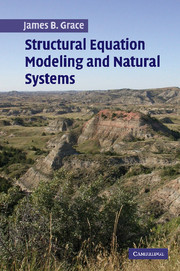Structural Equation Modeling and Natural Systems

This book presents an introduction to the methodology of structural equation modeling, illustrates its use, and goes on to argue that it has revolutionary implications for the study of natural systems. A major theme of this book is that we have, up to this point, attempted to study systems primarily using methods (such as the univariate model) that were designed only for considering individual processes. Understanding systems requires the capacity to examine simultaneous influences and responses. Structural equation modeling (SEM) has such capabilities. It also possesses many other traits that add strength to its utility as a means of making scientific progress. In light of the capabilities of SEM, it can be argued that much of ecological theory is currently locked in an immature state that impairs its relevance. It is further argued that the principles of SEM are capable of leading to the development and evaluation of multivariate theories of the sort vitally needed for the conservation of natural systems. Supplementary information can be found at the authors website, accessible via www.cambridge.org/9780521837422. Details why multivariate analyses should be used to study ecological systems Exposes unappreciated weakness in many current popular analyses Emphasises the future methodological developments needed to advance our understanding of ecological systems.
Supplementary information can be found at the author’s website, accessible via www.cambridge.org/9780521837422.
James B. Grace

He obtained his Bachelor of Science from Presbyterian College his Master of Science from Clemson University and his Ph.D. from Michigan State University. He served on the faculty at the University of Arkansas and later at Louisiana State University, where he reached the rank of Professor. He has, for the past several years, worked at the US Geological Survey’s National Wetlands Research Center in Lafayette, Louisiana where he is a Senior Research Ecologist. He holds an Adjunct Professorship at the University of Louisiana.
USGS scientists have been involved for a number of years in the development and use of Structural Equation Modeling (SEM). This methodology represents an approach to statistical modeling that focuses on the study of complex cause-effect hypotheses about the mechanisms operating in systems. SEM is increasingly used in ecological and environmental studies and this site seeks to provide educational materials related to that enterprise. This site serves up tutorials, exercises, and examples designed to help researchers learn and apply SEM. Please click on the “Science” tab to learn more.
Click following link: USGS SEM tutorials